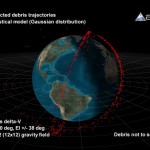This week we wonder if the Universe is going to collapse and then expand again, how satellites can have such different velocities, and the size of the observable Universe.
If you’ve got a question for the Astronomy Cast team, please email it in to [email protected] and we’ll try to tackle it for a future show. Please include your location and a way to pronounce your name.
Click here to download the episode.
Or subscribe to: astronomycast.com/podcast.xml with your podcatching software.
Questions Show- Transcript and show notes.


Is it so improbable that the ‘big bang’ wasn’t so big and is simply a phase of energy morphing into matter we see? And couldn’t this transformation be continuing today at some undetectable rate?
Chuck just listen to the podcasts. Your questions will be answered. These podcasts are very good.
Olaf, While the podcasts are ‘thought stimulating’, my basic question of ‘energy morphing into matter’ and maybe still in progress hasn’t been answered. The idea that all that we see just ‘popping’ into existance in an instant appears faulty to me.
Chuck it may be faulty to you but all evidences, observations experiments across many different disiplines of science all point to this Big Bang as source of all energy and matter in this universe.
Whe will learn more about this big bang when the Large Hadron Collider is active again. This is research into the big bang itself
Olaf, I have no quarrel with the evidence, observations and experiments suggesting a ‘big bang.’ My quarrel is with the instantaneous birthing of all matter and energy commonly refered to as the ‘big bang.’ Something from nothing in an instant violates logic. There must have been something before the ‘big bang’ for it to feed on.
@ Chuck Lam The April 2009 issue of Astronomy magazine has a fascinating article (on pp 28-33) by Paul Steinhardt of his “cyclic universe model” in which the universe has no beginning or end and undergoes periodic changes of expansion and attraction, thus negating the single event postulated by Big Bang adherents. Also, Andre Linde & colaborators have proposed the “Eternal Inflation” model to explain the cosmos as we see it today. These and other cosmological models are being refined to make predictions that may prove or disprove some of these models of our Universe’s evolution. It must be noted, however, that these alternative theories of the formation of our universe are stlll in their infancy and will need rigorous studies to see if any of these alternative models turn out to be the correct one.
Also a static universe as Chuck is thinking about have een studied more than enough because in the beginning they thought the universe was statuc. Whatever it is, it is going to be stupidly simple once you know it.
A lot of formula’s do exist, but the question is always as usual, what do these numbers mean and how can we translate them to things we humans can understand.
For example the superstring theory tells us that there could be 11 dimensions, try this to visualize as a human. But in formula form it is easily to formulate nd work with.
Even what we knap about the atoms does not match what we learn in school about the atom. What we learn in school is a oversimplified version of the real atom.
The thing is that the big bang is nearly impossible for humans to compare with what we know from our own regular lives. All concepts of before and after do not exist during the big bang since time did not exist.
To Olaf, I’m not ‘thinking’ a static universe. But more like an infinite void where the conversion of energy into matter at some undetectable rate has been occuring randomly through out this unlimited void these past 14 or so billion years. I just read Jon Hanford’s post about some current thinking of a ‘cyclic universe’ by Paul Steinhardt. I believe Steinhardt is on to something. Occum’s razor comes to mind.
@ Chuck Lam: You might want to check out Paul Steinhardt’s homepage for a wealth of papers & links regarding his “cyclic universe” models & links to other similar sites @ http://www.physics.princeton.edu/~steinh/ .At least his ideas are grounded in accepted theory and do not violate precepts of the Standard Model, but only suggest extensions to the model.
Hey, cool tips. Perhaps I’ll buy a bottle of beer to the person from that forum who told me to visit your blog 🙂